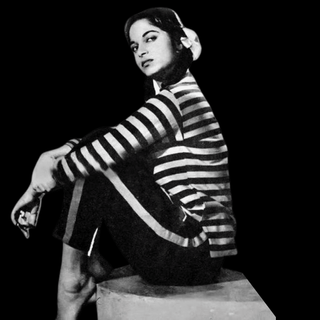
The Secret Lives Indian Women Lead on Balconies
Despite being a semi-public space, balconies are where women can kiss, drink, and be merry in a world of their own.

In the suburban Bhandup in Mumbai, Ashwathi lives in a corner house. The slight curve of the balcony, where the 23-year-old spent time studying or playing house, was also where she fell in love with her first girlfriend.
“When everyone was asleep, I would pretend to play with my cats and be outside till 4 a.m. some nights,” she says. “Talking to [my partner], getting to know her. In the end, loving her as well.”
Like a kaleidoscope, the balcony takes on new meaning for whoever views it. The visual of young or middle-aged women — as mothers, sisters, friends, individuals — shows the many ways women interpret and use balconies. Some are lost in thought, others furtively engaged in phone calls; some pursue a romance with a neighbor and resist familial pressures, others navigate privacy and leisure.
The balcony hosts all things they cannot do at home, or prefer to do in a place not immediately visible. It provides a certain vantage point; a space that is neither in the home nor the public domain. It’s like being in the backseat of a cab, looking out at the world unencumbered. “Seen from the ground, perhaps, balconies do serve as intermittent islands of privacy — balancing visibility and invisibility through the built and natural environment,” notes researcher Mahima Taneja. Ashwathi compares it to being hidden in plain sight.
***
Across the world, the balcony served the functional purpose of ventilation and better lighting at the start. Eventually, it became a place to hide women — to show the world to them but not them to the world. Take the jharokha-style balcony in Rajasthan, for instance, well-known for “protecting” women from the sun. “Since they observed purdah and couldn’t step out of their havelis and palaces, [women’s] interaction with the outer world was confined to the balconies,” historian Bela Ahuja told Firstpost.
Today, the balcony is a space of possibility and paradox. On the one hand, it arguably entrenches ideas of domesticity. It is associated with women drying clothes, or older women surveilling the morality of the young. Shruti Patil, a gender and urban researcher, notes this cultural anxiety: people frowning over lingerie drying out in the open became a matter of contention in society.
But it can also offer potential spaces of relief and escape. For some, it becomes a site of resistance to patriarchal norms by finding privacy and peace. Patil argues that you can claim “your space on your balcony despite the possibility of someone looking in.”
Related on The Swaddle:
Tell Me More: Talking Urban Women’s Safety and Access With Dr. Shilpa Phadke
For other women, balconies have been spaces where they discovered themselves and their hobbies, sometimes becoming “accidental entrepreneurs.” Ekta Chaudhary, for example, started a YouTube channel from her balcony called “Garden Up,” exploring greenery and sustainability in daily living. Now, it’s a whole company that deals with home decor and workshops. Ekta’s story is unique and familiar both; the balcony as a place to understand one’s relationship with oneself and find the space to build ideas — resisting a narrow idea of domesticity.
The balcony means different things to different women. It is a “space for women to gaze upon the world in a way they’re not permitted to within the household — within these patriarchal structures,” Sneha Annavarapu, a gender and urban city researcher notes.
Researcher Nathaniel Coleman argues the balcony functions as a third space, an “in-between realm” that can redefine meaning and purpose by negotiating new social norms. “It is a liminal space, on the edge of the domestic walls, the only space that now allows us to keep in touch with the outside, with other people, even though from afar, while staying inside our own home,” Domus Web explained.
Trupti Hathi, 51, calls the balcony a “private-public partnership.” Hathi saw her life unfold on the balcony. In school, it was her place of study; while working, it is where she would come to relax during holidays. When she was younger, It is also where she would speak on a call with her husband-to-be. As a mother, she used to keep her daughter busy with toys on the balcony. “For me, it is a private place which I can share with myself — the place where the public can see me, but I’m blissfully unaware of being perceived.”
For Jalasami Hathi, 25, Trupti’s daughter, the balcony is more of a refuge. She rushes to it to escape body shaming or marriage discussions. “You can cry in peace there.”
When you think of Romeo and Juliet, you think of the famous balcony scene that allowed Juliet to access forbidden love. In its Indian adaptation, Ram Leela, Leela again challenges restrictions over who to love and how to live by creating possible spaces of dissent on the balcony.
Old and new can exist side-by-side on a balcony. In A’s* balcony, for example, her mother would lay out papad in the morning, while her sister would sneak out for a smoke in the evenings.
“I think there’s something very interesting about how balconies have functioned and fostered the intergenerational relationship between women,” Annavarapu remarks. For Ashwathi, the balcony is where “us women,” her mother and her, bonded — over plants, cats, and gossip. “It gave us a space that is ours alone.”
Related on The Swaddle:
Indian Culture Normalizes Spying. This Affects How We View Digital Privacy
Women are hard-pressed to find privacy in traditional households. There are rigid expectations of how to behave or how to be with yourself. Researchers argue this is because women don’t exist as a “homogenous whole.” “The female body is thought of only in places where socially-constructed roles need ‘special’ care: the kitchen, public restrooms… Other than these very specific sites, very few sites exist where the female body is taken into consideration while building private spaces,” researchers wrote. Claiming the balcony as one’s own is, then, a subversive act.
During the lockdown, balconies represented leisure for women with kids and/or had other people live with them. “I go to the balcony when I am free – to watch other people, to look at the sky, to have tea – in my own home, it does embody a leisure space and a leisurely time,” says Taneja.
The balcony, by offering a place to think and engage, becomes an extension of the person. Trupti’s current house doesn’t have a balcony, and it’s all she longs for.
It “bridges the world outside and the inner confines of the dweller,” as Ahuja noted. Think Rapunzel, who uses the balcony to find and rescue herself. Balconies mediate the emotional space and the physical one.
As a liminal space, the balcony also promises women freedom in engaging with the city and community. There have always been spaces for men to relax — on the street, restaurants, other public spaces. Women, on the other hand, have struggled to find equally welcoming spaces — in the public or private domains.
The balcony recreated a place of leisure and loiter. “Traditionally, the home has always been considered the woman’s space; women were not to loiter the streets, women were not to claim the public sphere,” Open Magazine noted. Balconies offer a hint of the home and public space, both being reclaimed.
In cultural memory, an image symbolizing freedom comes in the form of Nescafe ads. A woman jaunters out to the balcony and sips coffee with relief on her face. “I hadn’t seen women in my life experience that kind of relaxation — this kind of urban leisure experience just by drinking coffee on your balconies. Growing up, that was aspirational for me,” says Annavarapu.
Back in Rajkot, Jalasami Hathi would sit on the balcony during the pandemic to socialize with passersby. The immediate privacy, while also allowing one to feel like they’re still part of a town or city – was a special antidote to the pandemic isolation. After all, as Italian cartoonist Makkox said, “balconies were the first social media.”
Annavarapu poetically summarizes this meditation on balconies. “In the night, I will gaze into the world outside with a glass of Malbec in my hand, and I will write love letters…
“I will cry; I will sing; I will dance; I will laugh; I will live.”
Saumya Kalia is an Associate Editor at The Swaddle. Her journalism and writing explore issues of social justice, digital sub-cultures, media ecosystem, literature, and memory as they cut across socio-cultural periods. You can reach her at @Saumya_Kalia.
Related


Woe Is Me! “I Want to Marry Someone Tall. Am I Shallow?”
